Why Are Clay Pigeons Called Clay Pigeons?
Clay pigeon shooting has turned into a real sport enjoyed by all types of people. Thanks to evolution, this sport could reach so far.
Now, why are clay pigeons called clay pigeons if there’s no real pigeon?
Well, back in the day, live bird shooting was a thing, and a real bird was thrown from a trap so that shooters could aim for the moving target and fire pellets using a shotgun.
Later, due to public outcry considering animal cruelty, a substitute was invented, hoping that it would mimic the pigeon’s flight and ensure delivering the same satisfaction as firing a live bird.
Soon after the first substitute, glass balls (filled with powder or feathers) were replaced by disks engineered from clay. It successfully provided a better and truer feeling that was on par with shooting a pigeon.
And that’s how the term clay pigeons came into action, from live bird shooting to clay pigeon shooting. To know further, check out this informative guide below.
Looking For More Blog:
Why Use Animal Terminology of All Things?
You must be lost, wondering why it’s called clay pigeon shooting if there’s no pigeon or bird involved.
Well, you do have a point, but if you hark back to the 80s or 90s, you will see how enthusiastic people were when it came to bird hunting or live bird shooting competitions.
It used to be one of the most thrilling sports among all classes of people. And,what made it more compelling was the wagering. The audience would put money on the targets, and whoever won would receive a fortune.
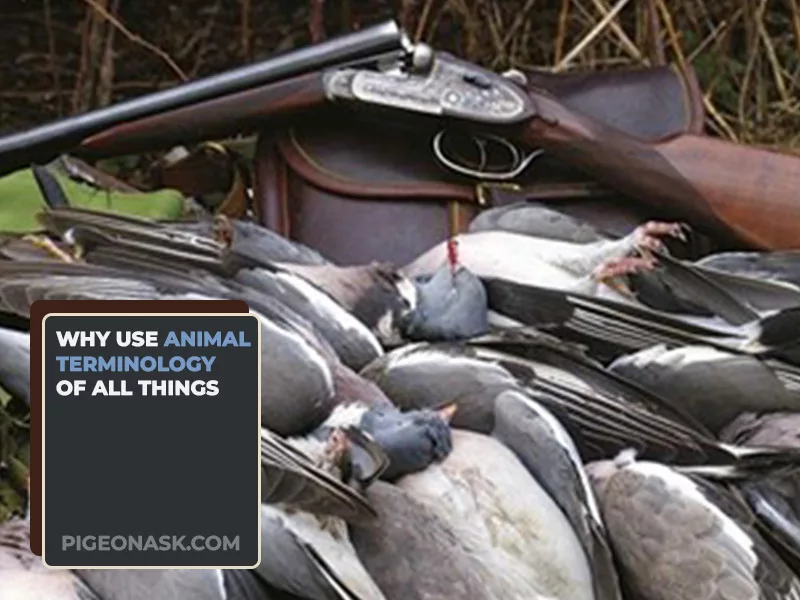
If you think about it, the sheer anticipation of killing a live bird with your exemplary shooting and aiming skills while having other people cheering and rooting for you is fascinating.
Also, I personally believe any type of sports has the elixir to fuel your confidence as well as your self-worth. Therefore, the involvement of a live bird is necessary, and it feels more real.
Since you can’t have real pigeons to be your target anymore due to the demise of public animal cruelty, at least the terminology can simulate the emotion and do some justice.
Also, let’s not forget that the machine that releases the target is referred to as a ‘Trap’ where one trajectory can be a bolting rabbit or another can be a dropping duck.The main objective was to mirror the original bird shoot by making the fake shoot as real as possible.
No wonder before the arrival of clay pigeons, they would brim over a glass ball with feathers and powder to simulate the sense of hitting a live bird.
What Is the History of the Clay Pigeon Shooting?
Around 70 years ago, Cincinnati Trapshooter pioneered the first ‘Clay pigeon,’ which kept evaluated in different forms and underwent a myriad of alterations to appease the ‘bird shooting’ lunatics.
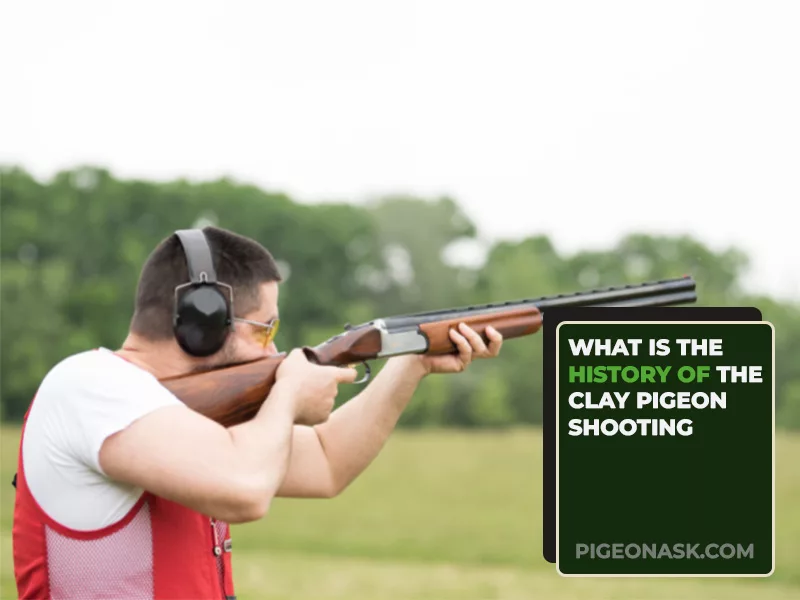
The Cincinnati Trapshooter, George Ligowsky, demonstrated the first clay pigeon in 1880. It was held at Coney Island, New York, by the inventor, and it was quite a sight. No wonder it got massive exposure from the audience back then, and the news was everywhere, which made it surge worldwide.
How Clay Pigeons Came Into Play?
Ligowsky introduced clay pigeons as a substitute to another substitute, the clay balls, which were invented as a rebound for live pigeons in trap shooting.
To emulate the pigeon’s flight, many people had made what you would call Rube Goldberg-like attempts apart from inventing glass balls to deliver a somewhat similar effect as the pigeons.
After the civil war, modern-day shooters tried to produce different gadgets to imitate a real pigeon even though Ligowsky introduced the first-ever model of clay pigeons.
You can take a detour to the 80s, the 70s, or even the 60s; regardless of how far you look back in history, you will stumble upon many substitutes (some failed, some prevailing) that were invented to replace live pigeon shooting, such as glass ball shooting then clay pigeons.
Clay Pigeons in Popinjay Shooting?
Homer speaks of a popinjay shooting in the ILIAD. In this sport, the Greeks would fire pellets at a dove.
It was vastly popular during the Middle Ages when a popinjay was basically a stuffed parrot mounted atop a pole. While the live birds were weaponized to hold these competitions, a string would keep the bird from flying afar.
The final popinjay public shooting took place in 1792 in England, where a bow and arrow was used. Then trap shooting came into action before 1856 in England by the frequenters of low public houses.
After that, different groups and clubs tagged along and made their own version of pigeon shooting using diverse substitutes. Shooting clay pigeons is one of them and the most prevailing one.
The Evolution of Clay Pigeon
Ligowsky went through a lot of backlash and criticism after he introduced his first clay pigeon model since it was made of actual clay.
You can’t really blame him, as it was his first endeavor considering he didn’t comprehend that you can’t make clay targets out of clay.
As if that wasn’t bad enough, he fired his first clay target in a kiln until it was too hard to break. It was almost like bricks that wouldn’t wither at all.
If you’d hit them, they would emit a piercing noise. Thanks to Ligowsky for renouncing the idea of using clay to form clay pigeons; otherwise, it would have been the end of his creation.
The modern-day target used for the sport are generally in the shape of an inverted saucer made by a concoction of pitch and pulverized limestone rock.
It was engineered strategically in a way, so it could withstand being fired from traps at full throttle yet vulnerable enough to be broken when hit by just a few steel pellets or lead from a gun.
Now what makes the new generation clay pigeon so admirable and of practical use is that the gadget renders the target spinning through the air.
The throwing device that is referred the trap is now available in a plethora of types and sizes, and some are for trap shooting while others are used for skeet shooting. And the rest is used for practicing.
As the trap device can release its target both mechanically and electrically, many people still throw their own targets manually.
The Doom of Live Pigeon Shooting
By 1921 live pigeon trap shooting had come to a halt, at least in Britain. The public outcry changed the perception as it wasn’t morally acceptable to hold live birds captive and to be gambled for recreational activities or fun.
With the doom of live pigeon shooting, clay target shooting came into play even though it had been there for decades.
In its initial days, the clay target shooting mirrored live pigeon trap shooting with a bunch of traps accessible to the shooter, elevated at a fixed distance.
The first emulated targets were balls, such as hollow balls crammed with feathers to be clear.
Later, a better glass ball trap was introduced and patented in 1977 by an American named captain Adam Bogardus. These glass balls were tailored from the pitch, which was relatively less messy and fatal.
The evolution of the trap went hand in hand with the development of the target.
Credit to George Ligowsky from Ohio, who invented clay pigeons, a domed sauced made of real clay. It also had a tab affixed to it for throwing.
Are Clay Pigeons Harmful to Cattle?
The answer is both yes and no. It depends on how the clay pigeons are made.
If the clay pigeons are made of toxic, non-biodegradable elements, then it’s undoubtedly harmful to the cattle, as after you shoot them, they will scatter on the ground but not dissolve entirely.
It will become a permanent resident of the environment and keep discharging toxins that are fatal for cattle.
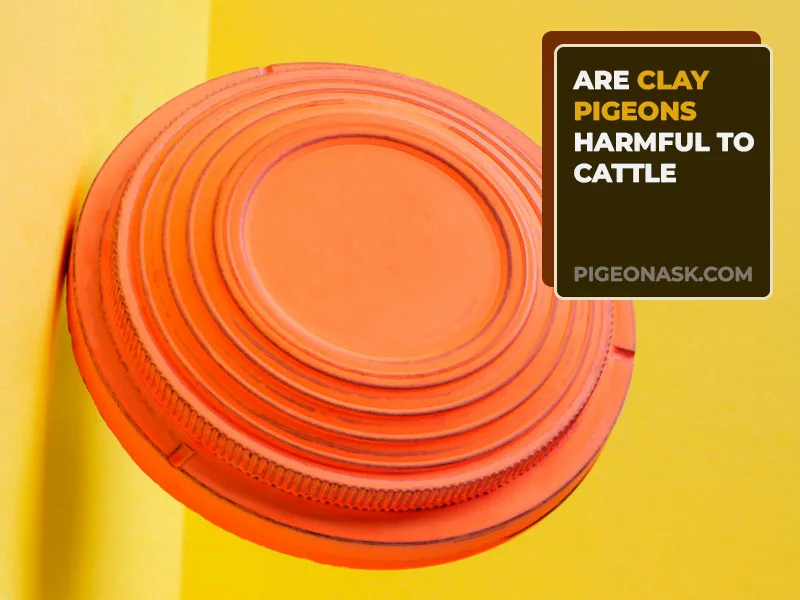
Plus, if an animal tries to consume the charred clay pigeons or whatever is left of them, then they might choke on it and die.
For instance, if the clay pigeon is fashioned conventionally, then it’s probably made of milled limestone and petroleum pitch.
While the limestone may not endanger the environment, the latter will, given it’s not nearly eco-friendly as it’s a form of plastic.
And as you already know, plastics don’t dissipate, they only morph into microplastic, then nano-plastic, and then permanent residents of this planet earth.
In contrast, if the clay pigeons are made of non-toxic materials like birdseed and sugar, then it’s not a threat to the cattle.
Biodegradable clay pigeons break down fats. Thus, by the time an animal notices, it will be already out of the picture.
What Is the Difference Between a Clay Pigeon and a Real Pigeon?
A real pigeon is a living being that mates, breeds, builds a nest, fends for itself, and keeps the cycle going.
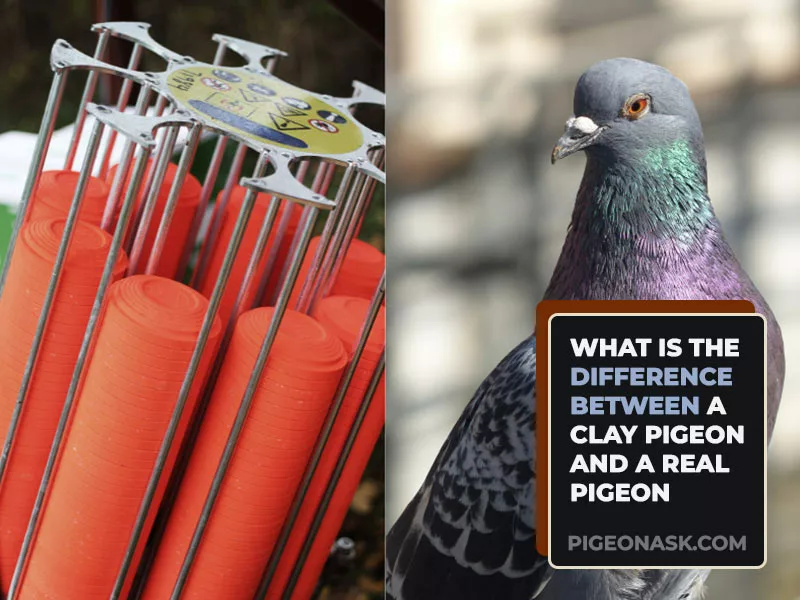
While on the other hand, clay pigeons don’t even look like pigeons as you might envision; however, they are made of clay and molded like small Frisbees, so you can throw and smash them all you want.
What Are the Different Types of Clay Pigeons?
Primarily there are six types of clay pigeons such as the standard, the midi, the mini, battue, shondel, and the rocket.
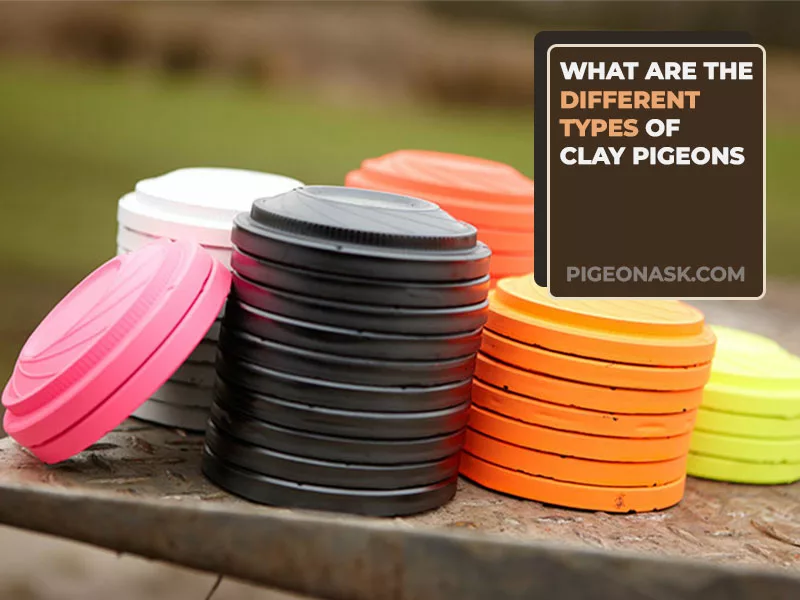
Each of them has its own characteristics or flight characteristics that you should be aware of.
The Standard and Midi Clay Pigeon
The standard clay pigeon (110mm in diameter, painted in dark orange and 25 mm in height) and the midi (90mm in diameter, 25mm in height) both can be thrown by the course setter at once, and it’s done to deceive the shooter.
Due to its similar looks and flight speed at the beginning, the course setter hoodwinks the shooter into believing both are the same, and you might confuse the midi as a standard or vice versa.
That’s when you fail at shooting the target, as the standard-size clay pigeon won’t lose its speed as rapidly as the midi does.
The Mini and Battue Clay pigeon
Similarly, the mini clay pigeon has the same shape as a standard clay pigeon but is only 60mm in diameter and 20mm in height.
This can also produce a deceptive image as it will be released from the trap at maximum speed, almost like the standard and the midi; however, the speed will deteriorate, making it hard to estimate the lead.
On the other hand, when you are trying to simulate a live shoot, you should try the mini or a battue (same as the standard clay pigeon in diameter but only one third the height) as it flies very rapidly and hits the bottle quickly.
Other types are not as popular as the first four; however, the difference resides in size, flight rate, descending speed, and color.
And it’s made in an array of sizes just to deceive the shooters. Also, let’s not forget that the color of the clay pigeons also varies depending on the background.
The rule of thumb is to have a contrasting background so it can create a silhouette.
How Clay Pigeons Are Used Today?
Clay pigeons are used for shooting sports, perfecting shooting skills, and other recreational activities. The prospect is the same as before.
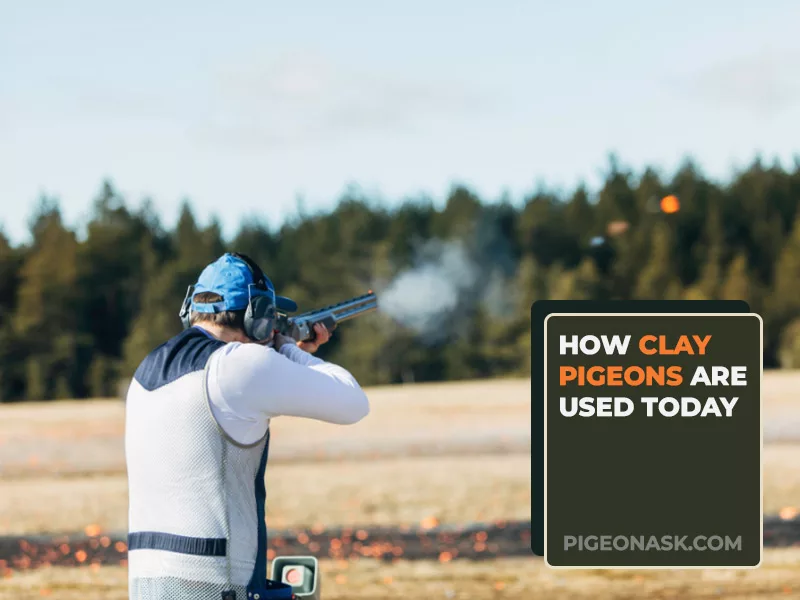
But how does it work in the present day?
Shooting competition
Clay pigeon shooting competition was always there from the beginning of civilization. The materials used in clay pigeons, the shape, the color, the flight characteristics, the shooting discipline, the weapons, the trap gadgets, etc., have been evolving since then.
However, the basic ground of the competition remained the same. This sport of clay pigeon shooting incorporates a shotgun and a target thrown from the trap. Once the target or the clay pigeon is released the shooter is supposed to aim at the target and fire pellets to break the circular flying target material and score points.
The target must be made of docile material so it can break and dissolve.
Honing up Shooting Skills
Hobbyists and both professional and entry-level shooters use clay pigeons to enhance their shooting skills so that they can have more chances to win and score.
Developing the skill is paramount as clay pigeon shooting can be really unpredictable and tough at times.
The person who monitors the trap will always try to deceive your eyes by throwing multiple clay targets at different flight speed. And as you already know how most of the clay pigeons look similar you can already assume how tricky it can get to discriminate between them and make the ideal strike.
Hence, shooters who want to have some aces up their sleeves and surprass mediocrity use clay pigeons for practicing.
End quote
Now that you have figured out why clay pigeons are called clay pigeons, it’s time to dabble into the crucial factors such as gun licensing, safety measures, the recoiling aspects etc.
Also, you need to consider the sports disciplines if you really want to give it a whirl.
In case you have any further queries or confusion to be cleared, make sure to leave a comment so I can help, gladly.
Article References:
- https://www.adventuresport.co.uk/blog/clay-pigeon-shooting-basics
- https://www.thamesleisure.co.uk/from-the-water-to-the-skies-clay-pigeon-shooting-on-boats/
Image Credits:
- Jack Scrivener
- Sportingtargets.co.uk
- Canva.com/phtos
